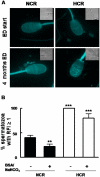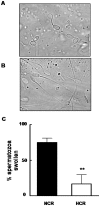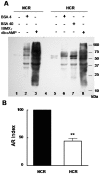Hypercholesterolemia impaired sperm functionality in rabbits
- PMID: 20976152
- PMCID: PMC2956674
- DOI: 10.1371/journal.pone.0013457
Hypercholesterolemia impaired sperm functionality in rabbits
Abstract
Hypercholesterolemia represents a high risk factor for frequent diseases and it has also been associated with poor semen quality that may lead to male infertility. The aim of this study was to analyze semen and sperm function in diet-induced hypercholesterolemic rabbits. Twelve adult White New Zealand male rabbits were fed ad libitum a control diet or a diet supplemented with 0.05% cholesterol. Rabbits under cholesterol-enriched diet significantly increased total cholesterol level in the serum. Semen examination revealed a significant reduction in semen volume and sperm motility in hypercholesterolemic rabbits (HCR). Sperm cell morphology was seriously affected, displaying primarily a "folded head"-head fold along the major axe-, and the presence of cytoplasmic droplet on sperm flagellum. Cholesterol was particularly increased in acrosomal region when detected by filipin probe. The rise in cholesterol concentration in sperm cells was determined quantitatively by Gas chromatographic-mass spectrometric analyses. We also found a reduction of protein tyrosine phosphorylation in sperm incubated under capacitating conditions from HCR. Interestingly, the addition of Protein Kinase A pathway activators -dibutyryl-cyclic AMP and iso-butylmethylxanthine- to the medium restored sperm capacitation. Finally, it was also reported a significant decrease in the percentage of reacted sperm in the presence of progesterone. In conclusion, our data showed that diet-induced hypercholesterolemia adversely affects semen quality and sperm motility, capacitation and acrosomal reaction in rabbits; probably due to an increase in cellular cholesterol content that alters membrane related events.
Conflict of interest statement
Figures





Similar articles
-
Semen quality and sperm function loss by hypercholesterolemic diet was recovered by addition of olive oil to diet in rabbit.PLoS One. 2013;8(1):e52386. doi: 10.1371/journal.pone.0052386. Epub 2013 Jan 11. PLoS One. 2013. PMID: 23326331 Free PMC article.
-
The sirtuin 1 activator YK 3-237 stimulates capacitation-related events in human spermatozoa.Reprod Biomed Online. 2023 Jan;46(1):165-178. doi: 10.1016/j.rbmo.2022.07.011. Epub 2022 Jul 19. Reprod Biomed Online. 2023. PMID: 36357302
-
The Presence of Seminal Plasma during Liquid Storage of Pig Spermatozoa at 17 °C Modulates Their Ability to Elicit In Vitro Capacitation and Trigger Acrosomal Exocytosis.Int J Mol Sci. 2020 Jun 25;21(12):4520. doi: 10.3390/ijms21124520. Int J Mol Sci. 2020. PMID: 32630462 Free PMC article.
-
Roles of intracellular cyclic AMP signal transduction in the capacitation and subsequent hyperactivation of mouse and boar spermatozoa.J Reprod Dev. 2013 Oct;59(5):421-30. doi: 10.1262/jrd.2013-056. J Reprod Dev. 2013. PMID: 24162806 Free PMC article. Review.
-
Markers of human sperm functions in the ICSI era.Front Biosci (Landmark Ed). 2011 Jan 1;16(4):1344-63. doi: 10.2741/3793. Front Biosci (Landmark Ed). 2011. PMID: 21196236 Review.
Cited by
-
High fat diet causes distinct aberrations in the testicular proteome.Int J Obes (Lond). 2020 Sep;44(9):1958-1969. doi: 10.1038/s41366-020-0595-6. Epub 2020 Jul 16. Int J Obes (Lond). 2020. PMID: 32678325 Free PMC article.
-
High cholesterol diet-induced testicular dysfunction in rats.Hormones (Athens). 2023 Dec;22(4):685-694. doi: 10.1007/s42000-023-00472-4. Epub 2023 Aug 18. Hormones (Athens). 2023. PMID: 37596375
-
Advantages of Curcuma longa in preventing male infertility caused by thioacetamide.Open Vet J. 2024 Jul;14(7):1585-1595. doi: 10.5455/OVJ.2024.v14.i7.8. Epub 2024 Jul 31. Open Vet J. 2024. PMID: 39175971 Free PMC article.
-
Body mass index is not associated with sperm-zona pellucida binding ability in subfertile males.Asian J Androl. 2013 Sep;15(5):626-9. doi: 10.1038/aja.2013.10. Epub 2013 Jun 17. Asian J Androl. 2013. PMID: 23770940 Free PMC article.
-
A Comparative Analysis of the Altered Levels of Human Seminal Plasma Constituents as Contributing Factors in Different Types of Male Infertility.Curr Issues Mol Biol. 2021 Sep 26;43(3):1307-1324. doi: 10.3390/cimb43030093. Curr Issues Mol Biol. 2021. PMID: 34698062 Free PMC article.
References
-
- Kannel WB, Castelli WP, Gordon T. Cholesterol in the prediction of atherosclerotic disease: new perspectives based on the Framingham Study. Ann Intern Med. 1979;90:85–91. - PubMed
-
- Yeagle PL. Cholesterol and the cell membrane. Biochim. Biophys Acta. 1985;9;822(3–4):267–87. - PubMed
-
- Visconti PE, Ning X, Fornes MW, Alvarez JG, Stein P, et al. Cholesterol efflux-mediated signal transduction in mammalian sperm: cholesterol release signals an increase in protein tyrosine phosphorylation during mouse sperm capacitation. Dev Biol. 1999b;214(2):429–43. - PubMed
-
- Eyster KM. The membrane and lipids as integral participants in signal transduction: lipid signal transduction for the non-lipid biochemist. Adv Physiol Educ. 2007;31:5–16. - PubMed
Publication types
MeSH terms
Substances
LinkOut - more resources
Full Text Sources
Medical

